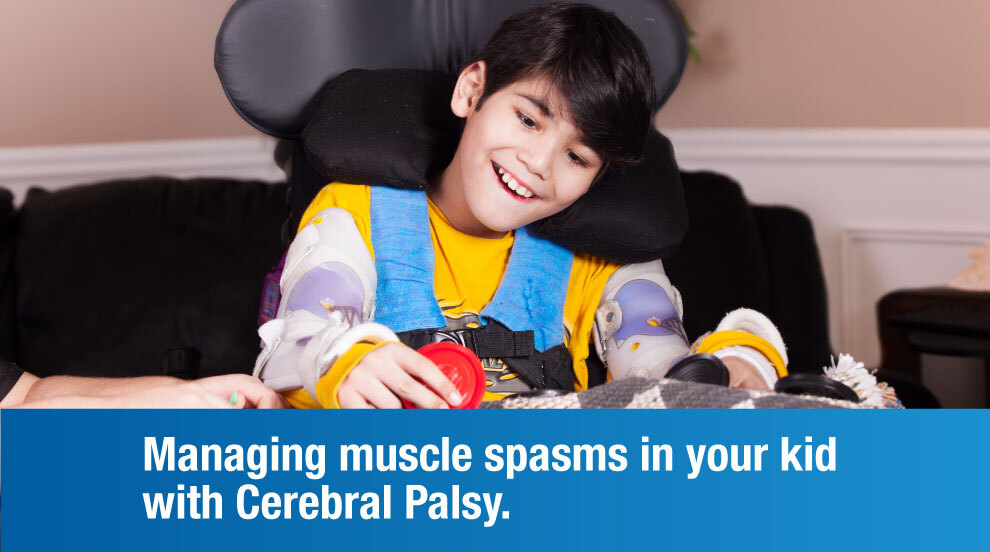
Cerebral Palsy poses unique challenges for children, with muscle spasms being a common source of pain and discomfort. Understanding the impact of cerebral palsy on muscle tone and coordination is crucial for parents navigating the complexities of their child’s condition.
Dear parents, let us explore the causes of muscle spasms in cerebral palsy, their consequences, and effective strategies for managing and improving the quality of life for affected children.
Understanding Cerebral Palsy and Muscle Spasms
Cerebral Palsy, a group of neurological disorders, disrupts movement, muscle tone, and coordination due to brain damage or abnormalities during development. Muscle spasms, a prevalent consequence, result in overly toned muscles that contract involuntarily, causing pain and hindering normal movement. These spasms vary in severity, impacting different muscles and leading to challenges in daily activities.
Causes and Consequences of Muscle Spasms
Causes of Muscle Spasms
The causes of muscle spasms in cerebral palsy are rooted in the damage or abnormal development of the brain, impacting the communication between the brain and muscles. This disruption leads to the overstimulation of muscles, resulting in involuntary contractions.
Consequences of Muscle Spasms
Muscle spasms in children with cerebral palsy contribute to chronic pain, restricting their ability to engage in daily activities. Simple tasks like dressing, eating, or playing become painful, affecting their overall quality of life. Additionally, the psychological impact of persistent pain can lead to emotional challenges, including depression, anxiety, and frustration.
Managing Muscle Spasms in Children with Cerebral Palsy
Regular Physical Therapy
Despite potential initial discomfort, regular physical therapy is absolutely vital for improving range of motion, joint alignment, and natural movement. Parents, do accompany your little ones to sessions, and provide support and comfort during exercises.
Proper Bed Positioning
Experiment with different bed positions to find the most comfortable one for your child. Invest in special equipment if necessary to ensure proper positioning, promoting better sleep and minimizing pain.
Mental Health Support
Chronic pain can take a toll on your little one’s mental health. Engaging in non-physically exerting activities together, such as listening to music or watching movies, can provide relief. A psychological counselor can help children cope with anxiety, frustration, or depression resulting from their condition.
Encouraging Activity
Despite physical limitations, encouraging your child to stay active is essential. Activities tailored to their abilities, such as walking and gentle movement exercises, contribute to overall health and may even reduce the frequency of muscle spasms.
Monitoring Signs of Pain
As a parent, you should stay attuned to signs of pain. Observing changes in facial expression, body language, or verbal cues helps identify when your child is experiencing discomfort. Open communication about their pain points can help receive prompt and effective treatment and care.
Medications and Treatments
Depending on the severity of muscle spasms, your child’s doctors and therapists may prescribe medications to alleviate pain and reduce spasticity. Botulinum toxin injections, baclofen pumps, and oral medications are common treatment options, and their efficacy should be closely monitored.
Note: Please do not treat this blog as a prescription. Before starting your child on any medication, it is important to consult your doctor.
Nutritional Considerations
A well-balanced diet, rich in nutrients, can contribute to overall health and well-being. And for little children, nutrition is key to growth and development. Adequate hydration and nutrition support muscle function and may indirectly influence the frequency and intensity of muscle spasms.
Assistive Devices and Orthotics
Utilizing assistive devices, such as braces or splints, can help maintain proper joint alignment and alleviate muscle spasms. Customized orthotics provide additional support and promote more comfortable movement.
Hydrotherapy and Massage
Hydrotherapy, involving exercises in a warm water pool, can provide therapeutic benefits by reducing muscle tension. Massage therapy, performed by a trained professional, may also help relax muscles and alleviate pain associated with spasms.
Parental Education and Advocacy
Empowering parents with knowledge about cerebral palsy and muscle spasms is crucial. Understanding the condition, its potential challenges, and available resources allows parents to advocate effectively for their child’s needs within the healthcare system and educational institutions.
Read 7 Tips for Parents of Children with Cerebral Palsy here.
Watching a child with cerebral palsy endure muscle spasms can be challenging for parents. However, with a collaborative approach involving a healthcare team, patience, and love, the impact of muscle spasms can be alleviated. While a cure may not be immediate, effective cerebral palsy treatment, including targeted therapies and supportive measures, can significantly reduce pain and enhance the overall quality of life for affected children.
FAQs
Does cerebral palsy cause muscle spasms?
Yes, cerebral palsy can cause muscle spasms. The neurological damage or abnormalities in the brain that characterize cerebral palsy disrupt the communication between the brain and muscles, leading to overstimulated muscles and involuntary contractions. These contractions are known as spasms.
How do you treat muscle tightness in cerebral palsy?
Muscle tightness in cerebral palsy is typically treated with a combination of physical therapy, medications, and orthotic devices.
Read more about physical therapy for cerebral palsy here.
What are spastic muscles in CP?
Spastic muscles in cerebral palsy are characterized by increased muscle tone and stiffness.Heightened muscle tone is caused by abnormal signals from the brain to the muscles, leading to involuntary muscle contractions. Spasticity can impact various muscle groups, affecting movement, coordination, and overall motor function.
What is the difference between spasticity and spasms?
Spasticity and spasms are similar, yet distinct phenomena. Spasticity (heightened muscle tone) causes stiffness and resistance to movement. Spasms are sudden and involuntary muscle contractions. Spasticity is a continuous state of heightened muscle tone. Spasms are intermittent and may be triggered by various stimuli.
Is spastic cerebral palsy curable?
Specific treatment and management strategies for spastic cerebral palsy aim to manage symptoms and improve quality of life. Interventions include physical therapy, medications, orthotic devices, and, in some cases, surgical procedures. Early and ongoing interventions contribute to improved quality of life for individuals with spastic cerebral palsy.










